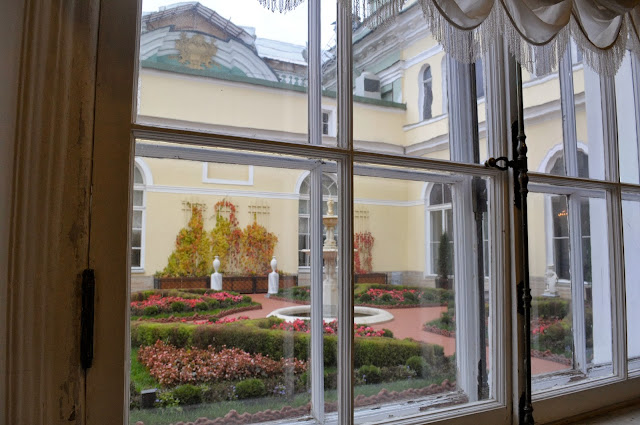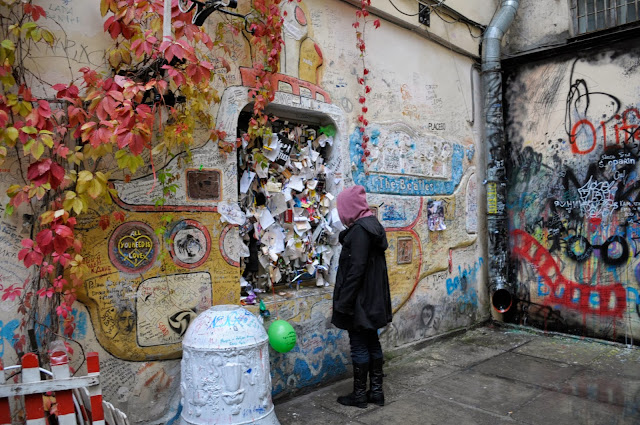Boat Tour
The first day began with a boat tour which, before arriving, seemed like a bit of an odd thing to me As it turns out St Petersburg is modelled on Peter the Great's favourite European city: Amsterdam. In fact when the city was first constructed there were many canals and no bridges as Peter wanted everyone to get everywhere by boat.
Our destination, the Peter and Paul fortress, is the oldest part of the city and the church inside houses the resting place of the Tsars and their families.
 |
| Final resting place of Tsar Nicholas II and his family |
The Church on Spilt Blood
This church was built on the site where Tsar Alexander II was assassinated. His blood was never washed off the pavement and the church was built and dedicated in his memory. It barely survived both WWII and the Soviet era but has since been painstakingly restored with restorations taking as long as the original construction time. The inside of the Church is covered entirely with mosaics covering a total surface area of more the 7500 square metres. As of now it is used as a concert hall with services still taking place on the anniversary of Tsar Alexander II assassination.
A Night out With Locals
On Saturday night we were split up into groups and went out and saw the city with local students. I may be a bit biased but our group was the best. We had three guides, non of whom were from St Petersburg. One came from the border with China, another from Islands near Japan and the third from Belarus. They took us to a popular Russian fast food chain that sold the best crêpes I've ever had. We then climbed St Isaac's Cathedral were we had a 360 view over the city where we even got to view a fireworks display. Afterwards we took a walk down the main street and headed to a little Jazz bar called "The Hat." Afterwards we briefly stopped by a club in what looked like an abandoned building where another group were spending their evening before heading over to the main river to see the raising of the bridges. Ever night around 1-2am the bridges go up so that cargo ships and what not can get through. It was cool seeing the ships come through so quickly in such vast numbers but the bridges going up meant that our guides were stuck in one part of the city until 5-6am.
The Winter Palace or The Hermitage
The Hermitage houses works of art collected predominately by the imperial family. It is made up of five or six buildings and apparently if you looked at every item for 1 minute, 8 hours a day it would take you 17 years to see everything. I have no idea how true that is but there is an awful lot of stuff on display. The main building is of course the old Winter Palace which is the green building beneath.
Free afternoon
 |
| Chocolate mousse cake of deliciousness |
 |
| St Nicholas' Cathedral |
A Day in the Life of.
One day in St Petersburg was dedicated to learning about life in both Soviet and Modern Russia. We visited a farmers market, a communal apartment, which still exist in abundance, and a homeless shelter as well as dropping by a vodka bar for a shot of (what else?) vodka. The Communal apartment was probably the most interesting though the homeless shelter definitely shed a lot of (very harsh) light on Russian homelessness and how the government fails them.
 |
| Original stove from 1917 |
The Ballet
No trip to Russia could be complete without a trip to the Mariinsky Ballet, formally known as the Kirov Ballet. We went to a performance of Balenchine's Jewels, with both the original choreography and replicas of the original costumes, in the new Mariinsky Theatre. It was of course an amazing performance with the Rubies soloist's debut and the principle dancers in Diamonds. It blew all of our minds and I'd be very surprised if the new soloist doesn't make principal in the near future.
Talks with Professionals
On our last day in St Petersburg we visited a former artists squat (now legitimate gallery) and talked to a former political prisoner who spent much of his youth fighting for freedom of expression in art followed in the afternoon by a writer who also spends much of his time translating English texts into Russian and vice versa. From both side we got a very interesting insight into culture both before and after the revolution. Others got to talk to two young politicians fighting for a more democratic Russia and another person who talked about small business in modern Russia.












































No comments:
Post a Comment